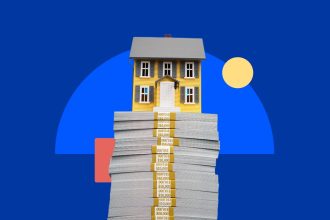Paul Hamilton/Getty Images
Key takeaways
- A 3/1 ARM is a type of adjustable-rate mortgage. The interest rate on this mortgage doesn’t change for the first three years of the loan term. The rate then changes once a year for the remainder of the term.
- The rate adjustment is tied to a specific index plus a margin determined by the lender. There are typically limits on how high your rate can increase during each adjustment and for the life of the loan.
- A 3/1 ARM usually comes with a lower rate to start. You’ll need to be ready for potentially higher payments once the lower, fixed-rate period ends and the rate resets.
What is a 3/1 ARM?
A 3/1 adjustable-rate mortgage (ARM) is a type of home loan that has a fixed interest rate for an introductory period, then a variable rate once the intro period ends.
These loans typically have a 30-year term. The interest rate is fixed for three years, then adjusts annually for the following 27 years.
You might also see the option for a 3/6 adjustable-rate mortgage. A 3/6 ARM offers three years of a fixed interest rate. After that, the rate adjusts every six months.
How does a 3/1 ARM loan work?
For the first three years, the 3/1 ARM functions just like any fixed-rate mortgage: You’ll make set monthly payments.
Once that three-year period is up, your rate adjusts on an annual basis. The lender can adjust it up or down based on the performance of the index tied to your mortgage, plus a margin set by the lender.
Some indexes lenders use to price ARMs include the yield on 1-year Treasury bills, the 11th District Cost of Funds Index (COFI) and the Secured Overnight Financing Rate (SOFR). If, for example, Treasury bill yields go up, your lender will increase your ARM rate. As a result, your monthly payment will increase.
Fortunately, ARMs generally come with adjustment caps. These limit how much your lender can change your interest rate, usually both at each adjustment interval and over the life of your loan.
Terms to know
- Introductory period
- This is the period of time before the interest rate starts adjusting. With a 3/1 ARM, the introductory period is three years.
- Introductory/teaser rate
- This is the fixed rate you’ll pay during the three-year introductory period. The primary benefit of this loan type is that 3/1 ARM rates are typically lower than comparable fixed mortgage rates.
- Adjustment intervals
- This is how frequently your lender changes the rate. With a 3/1 ARM, that’s every year. With a 3/6 ARM, that’s every six months.
- Initial adjustment cap
- This limits how much your lender can change your rate at the first adjustment. Some ARMs allow a larger rate change at the first adjustment than in subsequent years.
- Periodic rate cap
- This limits how much your lender can change your rate at each successive adjustment interval.
- Lifetime cap
- This lays out a ceiling limiting how much your lender can adjust your rate over the life of your loan. Essentially, it tells you the maximum rate you might need to pay if you keep the 3/1 ARM for the full loan term.
When to consider a 3/1 ARM loan
With such a short introductory period, a 3/1 ARM might work for you if you want to get into a home now at a lower interest rate but have plans to move in the near future. If your company is planning to relocate you in a few years, for example, that three-year introductory window could save you a lot of money. This type of mortgage can also make sense if you plan to refinance to a new loan before the low-rate intro period ends. When considering a 3/1 ARM, there are both pros and cons to keep in mind, including:
Pros of 3/1 ARMs
- Low interest rate at first: The primary benefit of this loan type is that 3/1 ARM rates are typically lower than standard 30-year fixed mortgages, at least for the initial three years.
- Lower mortgage payment at first: Because the rate is lower, your monthly mortgage payment is less. This might help you afford more house.
- Potential for rate decreases: There is some possibility that your rate could adjust downward. Be advised, though, that this is rare.
Cons of 3/1 ARMs
- High likelihood of rate increases: Historically, the indexes tied to adjustable-rate mortgages have increased. If you choose this type of mortgage, you should be prepared for your interest rate — and, consequently, your monthly payment — to go up after your intro period.
- Potential for financial hardship: If your rate does go up, it can make it more difficult to afford your mortgage payment.
How 3/1 ARMs compare to other loan types
A 3-year adjustable-rate mortgage functions a lot like any other ARM. The main differentiator with these loans is the length of the introductory period, during which the interest rate stays fixed.
Some other common ARMs include:
- 5/1 ARM or 5/6 ARM: The rate stays fixed for five years, then adjusts annually or every six months for the remainder of the loan.
- 7/1 ARM or 7/6 ARM: The rate stays fixed for seven years, then adjusts annually or every six months for the remainder of the loan.
- 10/1 ARM or 10/6 ARM: The rate stays fixed for 10 years, then adjusts annually or every six months for the remainder of the loan.
Generally, the longer the introductory period, the higher the interest rate will be during that window. For example, a 3/1 ARM will likely come with a lower introductory rate than a 7/1 ARM.
3/1 adjustable-rate mortgage vs. fixed-rate mortgage
In contrast to a 3/1 ARM, a fixed-rate mortgage keeps the same interest rate for the life of the loan. If you choose a 30-year fixed-rate mortgage, for example, your interest rate won’t change for those 30 years.
Most borrowers take fixed-rate mortgages because the monthly payments often end up lower over time compared to an ARM, and the fixed rate makes it much easier to budget. With a 3-year adjustable-rate mortgage, you could get in over your head if your rate adjusts too high.
Read the full article here
















